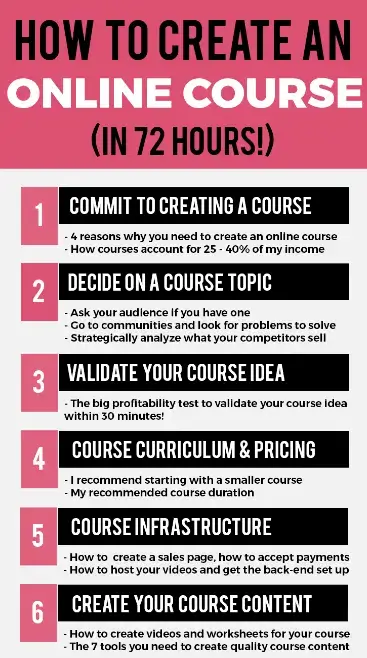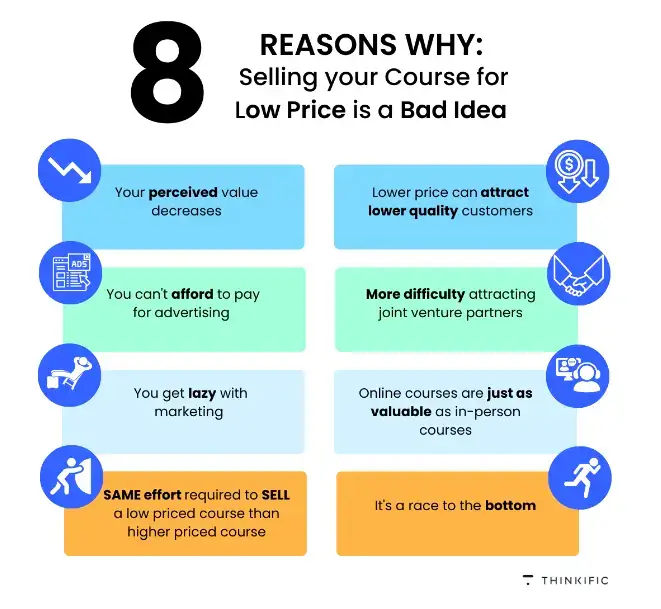Creating an online course and setting up ads to market it is just the start. To earn income from your e-learning courses, you must know how to price them appropriately.
Of course, the price that you set for each online course in your library can heavily impact your overall profit level, ROI, and more.
So, how do you price e-learning courses for max conversion optimization? Today, let's answer this question in detail.
5 Factors to Consider When Pricing an e-Learning Course
- Consider your experience
- Think about your "break-even" point
- How valuable is the e-learning course?
- Price your course by type and content
- Ensure you are charging appropriately
There are a few key factors you should think about when pricing your online course.
1. Consider your experience
First, consider the online learning experience that you bring to your learners. Someone might purchase a course from you because you are supposed to have unique insights or educational value.
Therefore, the more niche or unique your experience is, the better. If you are one of the few experts in a tiny field, you won’t expect to sell tons of courses to the general public.
But the few people in the same niche or industry who need the skills you can offer will be willing to pay a premium to take advantage of your experience.
Platforms like Kajabi provide an option for educators to offer course memberships, making it easier to build long-term relationships with learners.
In other words, the rarer your experience is, the more expensive your courses should be. The reverse is also true.
If you have a lot of experience in a relatively accessible industry, like marketing, your can sell your courses for a profit, but you shouldn’t sell them at premium prices.
Experiential learning allows students to apply what they've learned in a practical setting, which can lead to a better understanding and retention of the material.
Additionally, using calendar apps for college students can help manage time effectively for coursework and experiential learning.
So, not only can you make a profit from your courses, but you can also provide your students with the benefits of experiential learning.
2. Think about your “break-even” point
Next, do some calculations to determine the breakeven point when selling your courses. For example:
- Say you spend $2000 on digital marketing and price your course at $50 (forget that making a course also costs you significantly in terms of time and money).
- To break even or make back whatever you spent on marketing, you must sell the course to 40 different people. The breakeven point is different from where you become profitable, too.
- Now that you know this information, you can determine a given course's price level to make a profit. In the above example, you might price your course at $100. That would make your breakeven point just 20 sales, so every sale after that would technically be money in your pocket.

That said, your breakeven point isn't the only KPI (or key performance indicator) you should track. Conversion rate is an example of a KPI that impacts your profits.
It affects your brand. The more prospects converted into students or paying customers, the better you'll become as an online teacher.
Therefore, while your breakeven point is essential, you should consider other KPIs when pricing your course. It may be worthwhile, particularly at the beginning of a course’s lifespan on the marketplace, to price each course relatively affordably to get as many students as possible.
Once you’ve built up a loyal fan base, you can increase the prices of your courses accordingly.
3. How valuable is the e-learning course?
Look at the material in your e-learning courses and ask yourself these 4 questions:
- How valuable is the educational content?
- Do you include a lot of actionable exercises or assessments?
- Is your video content easy to absorb?
- Are you an excellent online teacher?

You can understand just how valuable your course is by answering these questions. It may also be worthwhile to ask yourself how much you would pay for the course, putting yourself in the shoes of your target audience member.
If you believe your course is truly valuable and unique, don’t hesitate to price it accordingly.
But if you know the course’s content and materials, you can easily replicate it elsewhere, reflect that in your pricing, and aim for a more budget-minded audience.
4. Price your course by type and content
While considering the above factors before pricing any course, you should also remember that some courses should be priced differently based on their type and content. Here are a few examples:
- Introductory or basic courses should be reasonably cheap, usually under $10 or up to $50. That’s because these courses don’t have a lot of content and won’t take very long to complete.
- "Mini-courses," which are usually anywhere between one hour to a few hours long, can be $50 to a few hundred dollars in total. Many students expect to complete a miniature course in a single sitting, such as on a weekend day.
- Flagship courses, or the most popular courses offered by your educational brand, should be priced upwards of $300 at a minimum and sometimes several thousand dollars apiece. That’s because these are the main products you sell, and pricing them too low could signal your audience that they aren’t worthwhile.
- Advanced training courses can be upwards of $5000. These are usually only pursued by knowledgeable professionals seeking advanced skills and qualifications. You can liken these two college or certificate courses, so the price should reflect their quality and value.
The more courses you create, the trickier it can be to organize your learning materials.
Partnering with an experienced elearning app development company can help streamline the process, ensuring that your courses are well-organized and accessible, providing a better experience for your learners.
Boost your platform’s capabilities by partnering with expert elearning software development to create engaging course experiences.
Products like The Learning Network can make it easy for you to organize and marshal all of your courses by type so you can better understand which ones should have special price brackets.
5. Ensure you are charging appropriately
There’s one more tip you should remember before deciding how to price your online courses: don’t lower your prices too much, no matter how tempting!
Perhaps somewhat counterintuitively, if you price each course you create too lowly for the market in an attempt to undercut your competitors, you may signal to your target audience that your courses aren’t worthwhile.
Your target customers won’t see a deal if you lower your prices too far – they’ll take the low prices as a sign that your courses are cheap or low-quality and will skip your class in favor of a competing course.

Indeed, raising prices can increase revenue and maximize profits in specific contexts. It’s possible to take this too far, but raising prices may indicate confidence in your product or course materials.
That can, in turn, signal to your audience that they will be better off buying your course instead of something else.
Not sure how high is too high? Generally, you should try to price your courses competitively with similar learning materials in your industry or niche.
That way, you can price your course slightly higher or lower than the most direct competitor without negatively affecting your audience’s read of your quality.
Wrap Up
There’s a balance to consider when pricing your course too low and too high. You should experiment with different pricing points and discounts for the best results.
As you gather more data, you can price your courses competitively and profitably each time you release new content.


